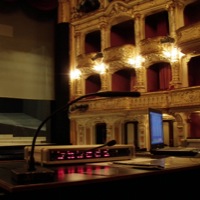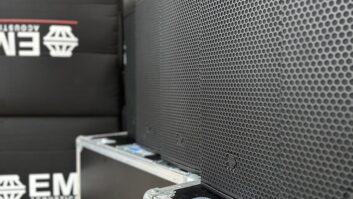
Few would argue with the suggestion that, in line with most other areas of pro-audio, intercom and paging technology has undergone a significant evolution during the last 10 years. Even so, in 2013, more venues than you might expect continue to rely on fixed two-wire paging and intercom systems, looping users into fairly simple rings. Rock-steady and reliable? Absolutely. Endlessly reconfigurable for different applications? Ah, now that’s where the limitations can begin to reveal themselves…
In which case, it’s hardly surprising that the primary watchword for R&D into venue communications these past few years has been ‘flexibility’. Hence, in particular, the ascendancy of sophisticated digital matrix intercom systems with extensive connectivity options and the ability to be distributed around venues.
In tandem with this development, venues’ growing sense of ease about multiple audio systems residing on one centralised backbone has made intercom design receptive to the audio-over-IP movement. Consequently, accommodation for current and future IP-based technologies is an increasingly central consideration.
More powerful remote and ‘virtual’ control requirements, as well as compliance with regulatory imperatives (most obviously, EN54-16), are among the other factors informing venue comms design – but more of that anon when Installation matches some current market-leading systems to various applications and operating circumstances. But first things first: what are the general circumstances in which a facility might need more than straightforward paging functionality – in other words, a dedicated intercom solution? Johannes G Rietschel, CEO and founder of Barix, is ready with a succinct summary.
“Paging and intercom are two separate things – although you often want to combine the functionality,” he says. “There may be security, reliability or operational reasons to ask for a standalone intercom solution. We also see cases where a ‘building paging’ system is already installed by the landlord and it is somewhat usable for paging, but the tenant then needs detailed zoning (still paging) or intercom – which we understand as being bidirectional, where someone in the building can talk back in a dialogue fashion with security personnel or an operator. This is typically not provided by a paging system.
“In such cases you would add an intercom system and likely connect it also to the paging system, if this is a requirement, so that you can use the intercom panels to make building-wide announcements through the installed overhead paging system.” 1) Paging, intercom for smaller venues; varying skill-setsThe adoption of intercom for houses of worship and other community-based spaces where technical knowledge may be limited has increased the demand for solutions that can be operated by untrained personnel. Barix has therefore placed an emphasis on security features designed to prevent unauthorised access and deliver ‘touch-free’ operation for intercom systems.
“We have introduced new intercom/paging solutions (Annuncicom PS1) and upgraded earlier products to full-duplex capability (PS16 paging master, Annuncicom two-way audio series) so that we can provide state-of-the-art intercom products that work for uneducated users,” explains Rietschel.
Meanwhile, the manufacturer’s modular, typically ‘serverless’ design means that the solution can be scaled up in relation to the current or future requirements of the venue. “There is no difference if you have one or 100 zones; one or 100 concurrent channels,” observes Rietschel.
Barix is by no means the only manufacturer to be keeping an eye on end-user skill-sets. Introduced at ISE 2013, Apart Audio’s AudioControl 12.8 paging matrix is a step up from the manufacturer’s previous capability of a four-zone matrix or a six-zone 100V paging system. Incorporating DSP processing and control possibilities, AudioControl 12.8 paves the way for Apart Audio to supply paging solutions for up to 16 zones when two matrices are linked together.Significantly, AudioControl 12.8 can also be deployed in three different modes, as Apart Audio/Audioprof sales & marketing director Kris Vermuyten explains: “The out-of-the-box mode where no programming or PC is needed; the installer mode, where only limited parameters can be changed; and the expert mode, where the integrator can configure the complete DSP with EQ, dynamics, macro programming, paging station and wall panel configuration.”
2) Combining matrix and partyline for small, medium-sized venuesAddressing the desire for what RTS senior sales manager Nico Lewis describes as “more intelligent point-to-point and addressable communication” is the RTS Zeus III LE+, a compact matrix intercom with 16 ports and a dual-channel partyline interface. “Now small and mid-sized theatres can install a matrix and integrate a partyline system with real full duplex point-to-point communication,” says Lewis.
ASL Intercom has also invested considerable time and energy into combining partyline and matrix functionality, resulting in the development of its Digital Series products. Susan McLohon, sales & marketing director of ASL Intercom, highlights the incorporation of daisy-chaining capability: “ASL digital allows a daisy-chain of eight stations whereby each station can be assigned to different groups. This allows the user to pull a Cat5 cable in one direction and [gives the user the opportunity to] connect anyone (eg ‘follow sports’, ‘dimmer city’, ‘amp city’) along the way.”
Biamp Systems, meanwhile, describes its Vocia DSP architecture as a “fitting solution” for applications such as 500-1,000-capacity multipurpose community hall/performance spaces – especially when deployed in combination with the AVB-ready Tesira scalable media system. TJ Adams, product manager for public address systems at Biamp, explains: “Vocia provides all of the paging station options, telephone paging and pre-recorded scheduled announcement capabilities for a higher-end facility of this type. The Vocia-Tesira system combination can also be used in certain regions of the world as the primary voice evacuation system, as well as for non-emergency type paging. [Tesira can be employed to] manage all of the conferencing requirements, room combining for ballrooms, general audio processing, EQ and large channel counts of audio matrices that are generally required in these venues.” 3) Intercom for training facilities… and moreNewly selected by Southampton Solent University for use in its OB vehicle, which is primarily used to media train students, is Trilogy Communications’ new Messenger intercom, which was debuted at CABSAT 2013. A single Messenger matrix can be expanded at any time to 16 or 24 panel/four wire ports and up to four channels of analogue telephone interfacing. Underlining the move towards IP-based operation, larger applications may be approached with the interconnection of multiple Messenger matrices via the optional IP gateway over any standard network.“We identified a gap in the market for an entry-level system that fundamentally supports the same SIP-style IP interfaces as Gemini [distributed matrix intercom system] and it’s already proven to be a highly compelling offer,” says John Sparrow, product sales manager of Trilogy Communications. 4) Intercom for large performance, sports venuesLike Trilogy, Riedel emphasises the fact that its intercom systems are “seamlessly expandable” – as with the Artist digital system, which can be grown from 32 x 32 matrices of 1,024 x 1,024 non-blocking ports. “For plus-4,000-seat venues, an Artist Digital Matrix intercom system in combination with digital trunked radios gives users the needed flexibility, redundancy and connectivity – including scalability of the system, if needed,” says Christian Diehl, Riedel’s product manager intercom.
Diehl also pinpoints the desire of larger venues, such as stadiums, to transfer their communications infrastructure to a fibre network, such as Riedel’s MediorNet. “Although it is not necessarily a communications system, it will give you a fibre network backbone, which can transport all the venue’s data – including HD video, audio and communications – in real time,” says Diehl. “[In particular] in large-scale venues such as sports arenas, this approach opens up a lot of possibilities and is a very cost-effective solution since it reduces the costs in installation and maintenance of multiple discreet networks.”
Fibre optic-based networking specialist Optocore is also well placed to acknowledge these wider transportation trends, having lately introduced interfacing solutions (X6R-FX-INTERCOM, V3R-FX-INTERCOM) that allow Clear-Com and RTS Matrix platforms to be integrated into the Optocore digital network system.
Optocore founder Marc Brunke says there has been “plenty of interest” in the interfaces among larger venues, not least because they “allow you to easily deploy keypanels on the matrix. For example, where a user might have put another matrix in a remote location to cover the necessary distances where only keypanels were required, they can now save on the cost of this one matrix and accommodate the remote location with keypanels.”
Clear-Com, meanwhile, has been experiencing strong take-up of its Tempest 2400 and Tempest 900 2- and 4-channel digital wireless intercom system among stadium clients. Once again, ease of integration with other venue systems is a key driver. “In the US, the need for wireless communications and tying in to Tempest with walkie-talkies, a matrix or existing partyline is what we are seeing a lot of here at Clear-Com,” says Vinnie Macri, product marketing manager at the company. The future = IP?The willingness for multiple systems to sit on the same network highlighted by Brunke and several others means that there is a general expectation that venue comms will – as Vermuyten remarks – “become more and more IP-based, allowing the integrator to monitor the unit from a distance or to control it with a tablet or smartphone.”
There’s no shortage of available audio-over-IP technologies, of course, but integration with standards-backed Audio/Video Bridging (AVB) networks is likely to be a recurring theme. Diehl remarks: “We believe that utilising large AVB-Ethernet infrastructures for real-time communications will be one of the major changes we will see in the future.”Accommodating current and future regulatory requirements will be similarly integral to new product design. Adams observes: “Proven, high-tech practices built into our products ahead of time, and the dedication to meeting life safety standards in some of the most stringent regions of the world, increases the futureproof abilities of our platforms and solutions.”
But although systems will continue to require greater ease of integration, many would probably concur with Brunke’s suggestion that intercom/paging design is likely to be characterised by “gradual evolution” – as opposed to a paradigm shift. Therefore, manufacturers who combine ‘classic’ and forward-looking design elements are destined to reap the greatest rewards over the next few years. www.apart-audio.comwww.asl-inter.comwww.clearcom.comwww.barix.comwww.biamp.comwww.optocore.comwww.riedel.netwww.rtsintercoms.comwww.trilogycomms.com







